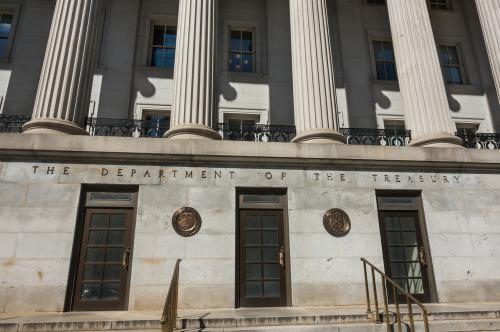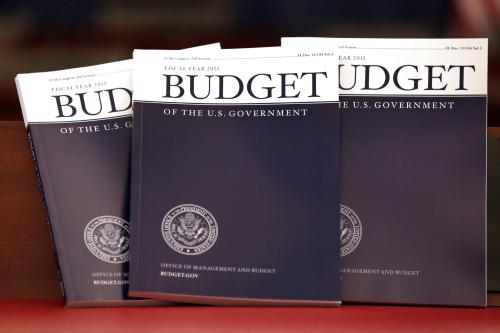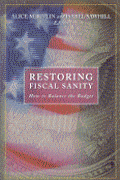This post originally appeared in Real Clear Markets on September 5, 2017.
This Congress has found it hard to take action on many pressing issues, such as health care. But one issue is definitely focusing the minds of lawmakers. That’s the debt limit – the statutory ceiling on how much the federal Treasury can borrow to keep the government functioning. According to Treasury Secretary Steven Mnuchin, if Congress does not increase the limit by September 29th, the government will quickly become unable to cover its obligations, forcing sharp program cuts and threatening the country’s credit abroad.
Some people argue that we should put an end to this regular example of financial nail biting by agreeing to raise the debt limit automatically as needed, as was in practice the case for part of the 1990s and 2000s. That’s an attractive idea in many ways, but requiring votes on the debt limit has been an important lever to get Congress to institute important procedural reforms that encourage lawmakers to make tough budget decisions.
“Must pass” legislation to increase the debt limit has long been used as the vehicle to pass other urgent or controversial bills, including changes in fiscal rules that pushed Congress to tackle the drivers of debt. For example, the Balanced Budget and Emergency Deficit Control Act of 1985 (better known as Gramm-Rudman-Hollings) was an amendment to legislation raising the debt ceiling, and established a deficit reduction procedure using automatic “sequestration” if needed. Similarly, the debt ceiling crisis of 2011 prompted enactment of the Budget Control Act, which created a joint congressional “supercommittee” tasked with developing a 10-year deficit reduction plan. Although the supercommittee deadlocked, the Act also contained backstop automatic spending cuts in defense and domestic spending.
A debt ceiling bill this September or October would be another opportunity to attach budget procedures to address our alarming long-term fiscal problem situation.
A debt ceiling bill this September or October would be another opportunity to attach budget procedures to address our alarming long-term fiscal problem situation. According to the Congressional Budget Office (CBO), the US faces “steadily increasing deficits and debt over the next 30 years – reaching the highest level of debt relative to GDP ever experienced in this country.”
Unfortunately, we need to be modest about what we can realistically expect Congress both to pass and adhere to in the future. Lawmakers have a bad habit of suspending or evading budget rules that make them politically uncomfortable. And currently there is little interest in the White House or Congress in enacting rules to address Social Security and Medicare, despite the fact that Medicare is the major driver of future unfunded obligations. Nor is there any Republican interest in procedures that would trigger tax increases if scheduled debt reductions are not achieved.
In this political context, it might be best to take an “indirect approach.” Thus rather than seek a high-stakes rule designed to have an immediate effect on deficits and debt, better to establish instead a new procedure that, over time, gradually increases political pressure on members to make more prudent budget decisions. The best way to do that might be to focus on generating certain information in a clear and high profile manner – information that increases public pressure on future lawmakers.
Earlier this year I co-authored a report arguing that Congress should enact a 25-year spending plan for major entitlements, including Medicare and Social Security, together with a firm funding plan to cover their cost. The plan could be modified every four years if the votes were there for a new plan, but otherwise it would be the default budget for these major programs. Although there is little prospect of anything that radical being attached to a debt limit bill this year, tucked within the proposal is an idea that just might gain traction on both sides of the aisle.
The idea is for CBO to assemble and publish a Quadrennial Report on Major Priorities and Goals. It would be modeled on the Quadrennial Defense Review, which maps out US strategic defense objectives and threats, and our capacity to address them. The Report would project the fiscal impact on long-term deficits and debt due to the major entitlement programs. It would do the same for the trends in major “tax expenditures” – the special tax breaks, like the mortgage deduction, that are actually very similar to entitlement spending.
The Report would also indicate the fiscal risks facing each of these programs to assess whether they could deliver their promised commitments – essentially a “stress test” for programs like Social Security and Medicare. Based on this year’s Social Security Trustees Report, such a test right now for Social Security would show its reserves plunging into the red by 2034 and that, to assure permanent solvency, there would need to be a large payroll tax hike or benefits would have to be cut by 23 percent that year.
While such information is already collected and published in some form, it appears in bits and pieces and in different places at different times. So press stories tend to be buried or short-lived. The purpose of developing a Quadrennial Report is to raise the public profile and impact of the information, by pulling all the key data together in one place, in a form that is easily accessible to the public, and issuing it at a strategic political time just once every four years. The ideal timing might be the January of each presidential election year, in order to force the long-term budget picture into the debate during the presidential and congressional elections. Ideally, the law creating the Report would also require at least a special congressional resolution responding to the Report. So lawmakers up for election would have to go on record on such things as whether they are content to see Social Security cut sharply in the future and, if not, to indicate their proposed solution.
The aim of a modest step like this is to build into the budget process a feature that focuses attention on the long term. Over time, that could change the underlying political conversation, making it a bit more likely that we will address the issues that drive deficits and our mounting debt – well before they reach crisis levels and our options become very limit and painful.










Commentary
Op-edWhy Congress must not let the debt limit crisis go to waste
September 5, 2017